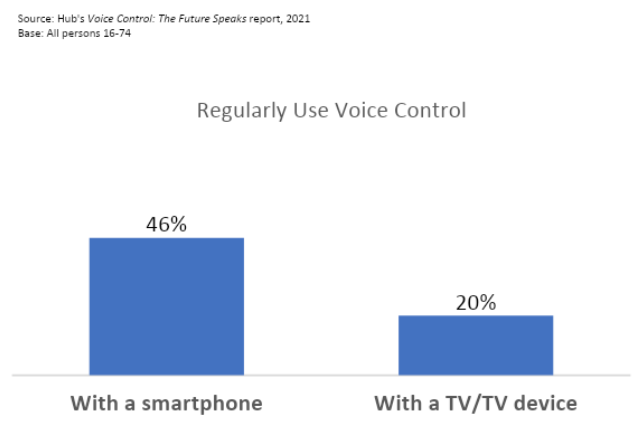Talking to Your TV Isn’t Crazy Anymore
Voice control isn’t the future… it’s now.
Using voice commands to control technology has gone from sci-fi to standard procedure in a very short time. Today, 62% of Americans say they regularly use voice control with at least one device—most commonly with apps on smartphones. Not only is voice control no longer an emerging technology… it’s as mainstream and close as your pocket or purse.
But People Don’t Have a Lot to Say to Their TVs
Thanks to COVID and the streaming wars, people are using their TVs more than ever. But despite the adoption of smart TVs and connected TV devices over the past few years, the use of voice commands to control TV content is still low.
According to a recent Hub Research report, only one in five (20%) consumers say they regularly use voice commands with TVs, TV remotes, or TV-connected devices—less than half the proportion who regularly use voice control with smartphones.
Why isn’t voice control used more for TV? Inertia certainly plays a part – viewers are creatures of habit, and even among those with TV devices that are capable of voice command, only 42% actually use it.
Among those who could use voice command but don’t…
About a third say they don’t even think about it (32%)
Another third (30%) say they are comfortable in their habit of watching without using voice commands
And a quarter see no advantage to changing habits and using voice (22%)
Ironically, these non-users typically search for TV shows or movies by using their remote to type into the search function of a streaming media player, smart TV, or cable set-top box. Have you ever experienced the frustration of using a remote to slowly move the cursor and click on each letter, over and over? It’s an exceedingly unfriendly experience in a world of user-friendly interfaces. One would think these viewers need only try voice command before they’d switch (assuming it works as advertised).
If You Can Lead the Horse to Water…
Which brings us to the good news: consumers who try voice commands are likely to continue using them. Almost all (93%) who use voice commands on a TV or streaming device are satisfied with the experience (including 53% who are “very” satisfied).
And what are the main uses of voice related to TVs? You guessed it, searching for TV programs or movies. It sure beats hunt-and-peck typing on a virtual keyboard.
Kids Have It Easy Today
The concept of controlling a TV set has seen a few steps in evolution. At first, Dad had to get up and walk over to the TV to change the channel. Then, Dad told the nearest kid to get up and change the channel. After remote controls became commonplace, Dad asked the nearest kid for the remote and changed the channel. Now, Dad can yell into the remote, or at the TV set, and change the channel.
Watching TV is an activity in which we develop habits that are hard to break. But the past few years have seen many habits change – such as streaming displacing linear viewing on a schedule, or bingeing replacing weekly episodes, or recommendations replacing channel surfing. So perhaps breaking the habit of using one’s fingers instead of one’s voice isn’t too far-fetched, especially considering the overall use of voice commands.
Whether it’s voice control or other new media devices, my past decades of experience in researching media technology adoption show that consumer education must continue throughout the traditional adoption lifecycle. It’s not enough to win over the early adopters – it’s really the late mainstream and laggards who need messaging to make them comfortable to change habits.
The evidence suggests the persistence of established habits will present speed bumps in the short term. But in the near future, voice command will be the default way consumers control their TV (and perhaps all media). It’s too good a solution for the most common viewer tasks for things to turn out any other way.



